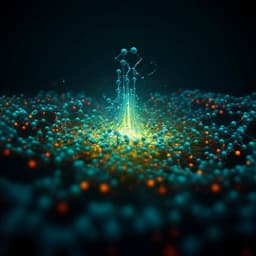
Chemistry
Direct synthesis of cyanate anion from dinitrogen catalysed by molybdenum complexes bearing pincer-type ligand
T. Itabashi, K. Arashiba, et al.
Discover how a team of researchers including Takayuki Itabashi, Kazuya Arashiba, and Akihito Egi has catalyzed the formation of cyanate anion from dinitrogen under ambient conditions using a novel molybdenum-carbamate complex. Their groundbreaking work includes a two-step synthetic cycle that showcases the potential for catalytic synthesis in environmental chemistry.
Playback language: English
Introduction
The conversion of dinitrogen (N₂) into valuable organonitrogen compounds is a significant challenge due to the inherent stability of the N≡N triple bond. The Haber-Bosch process, while currently used for ammonia production, requires harsh conditions and substantial fossil fuel consumption. Developing mild, direct synthetic methods for organonitrogen compounds from N₂ is crucial for sustainable chemistry. Transition metal complexes have been investigated for N₂ activation and functionalization for decades, with strategies focusing on either direct conversion into organonitrogen products or proceeding through metal-nitride intermediates. While significant progress has been made in stoichiometric reactions, achieving catalytic direct transformations of N₂ into valuable organonitrogen compounds under mild conditions remains a major goal. Isocyanates and their derivatives are particularly attractive targets due to their thermodynamic properties and widespread applications. Existing synthetic cycles for isocyanate derivatives from N₂ often involve multiple steps under varying conditions and utilize CO or CO₂, complicating catalytic implementation. This research focuses on developing a catalytic, direct synthesis of cyanate anion (NCO⁻), a derivative of isocyanates, from dinitrogen under ambient conditions. The authors build upon previous work involving molybdenum-nitride complexes bearing a pyridine-based PNP-pincer ligand, which have shown promise in catalytic ammonia formation. This study aims to explore the reactivity of these complexes with carbon-centered electrophiles, specifically chloroformate esters, to achieve the desired NCO⁻ synthesis.
Literature Review
The literature extensively documents research on transition metal-mediated dinitrogen conversion to organonitrogen compounds. Early works focused on the synthesis and reactivity of transition metal-dinitrogen complexes, particularly their reactions with carbon-centered electrophiles to functionalize coordinated dinitrogen. Cummins' group's milestone achievement of direct dinitrogen cleavage to synthesize nitride complexes opened a new pathway for organonitrogen synthesis. Subsequent studies have explored the reactions of transition metal-nitride complexes with electrophiles under mild conditions to create various organonitrogen compounds. Several groups have constructed synthetic cycles to produce organonitrogen compounds from N₂ using stepwise reactions with stoichiometric amounts of transition metal complexes. However, catalytic and direct transformations of dinitrogen into organonitrogen compounds under mild conditions have remained largely elusive. Previous attempts to synthesize isocyanate derivatives from dinitrogen involved multi-step synthetic cycles, often including CO or CO₂ which hinder the generation of metal-nitride complexes. These limitations highlight the need for a more efficient and catalytic approach.
Methodology
The researchers synthesized a molybdenum-carbamate complex ([Mo(NCO₂Ph)Cl(PNP)] (2)) from a molybdenum-nitride complex ([Mo(N)I(PNP)] (1)) and phenyl chloroformate. Complex 2 was characterized using NMR and IR spectroscopy. The key step involved the reduction of complex 2 with SmI₂ under an N₂ atmosphere. This reaction yielded the nitride complex 1 and cyanate anion (NCO⁻), which was quantified using ion chromatography (IC). Isotope labeling experiments using 15N-labeled phenyl chloroformate and 15N₂ confirmed that the nitrogen atom in NCO⁻ originated from the dinitrogen molecule. Further mechanistic studies involved the one-electron reduction of complex 2 with SmI₂, leading to the formation of an isocyanate complex ([Mo(NCO)ICI(PNP)] (4a)). The characterization of this isocyanate complex provided insights into the reaction pathway. The structure of several key complexes (2, 4a, and samarium complexes 3a and 3b) was determined via X-ray crystallography. Density Functional Theory (DFT) calculations were employed to investigate the reaction mechanism, focusing on the carbamylation step (1 to 2) and the subsequent C-O bond cleavage (2 to 4a). DFT calculations were also used to analyze the formation of a bridging dinitrogen dimolybdenum intermediate and its subsequent cleavage to regenerate the nitride complex. The feasibility of transferring phenoxy and/or isocyanate groups from the molybdenum center to a samarium(III) species was computationally explored to understand the role of SmI2 in the catalytic cycle. Finally, catalytic experiments were performed to evaluate the production of NCO⁻ from N₂ using various molybdenum complexes as catalysts, different chloroformate esters, and varying reaction conditions (slow addition of chloroformate), with NCO⁻ quantification via IC.
Key Findings
The study successfully demonstrated a two-step synthetic cycle for the formation of cyanate anion (NCO⁻) from dinitrogen using a molybdenum-PNP complex as a catalyst. The cycle involves carbamylation of a molybdenum-nitride complex with phenyl chloroformate to form a molybdenum-carbamate complex, followed by reduction with SmI₂ under a dinitrogen atmosphere. This reduction step generates the original molybdenum-nitride complex and releases NCO⁻. Isotope labeling experiments confirmed that the nitrogen atom in NCO⁻ originates from dinitrogen. DFT calculations support the proposed mechanism, showing a low activation energy for the carbamylation step and a facile C-O bond cleavage in the reduction step. DFT studies also explored the role of Sm(III) species in promoting the desired reaction and avoiding undesired side products. The reduction of the molybdenum-carbamate complex with a stoichiometric amount of SmI2 leads to the formation of an isocyanate complex as an intermediate. The isocyanate complex is further reduced with excess SmI2 to form the molybdenum-nitride complex and release another equivalent of cyanate anion, thus completing the catalytic cycle. The initial catalytic experiments resulted in the formation of a sub-stoichiometric amount of NCO⁻ relative to the catalyst. However, optimization through the slow addition of the chloroformate ester significantly improved the yield, achieving superstoichiometric production of NCO⁻, indicating the establishment of a true catalytic cycle. The choice of chloroformate ester was also found to be crucial, with methyl chloroformate yielding the highest catalytic efficiency due to lower reactivity towards SmI2. Bulky substituents negatively impacted the reaction efficiency.
Discussion
This research significantly advances the field of dinitrogen functionalization by demonstrating the first catalytic synthesis of cyanate anion from N₂ under ambient conditions. The two-step synthetic cycle, supported by both experimental and computational data, represents a highly efficient and streamlined approach compared to previous multi-step methods. The use of readily available starting materials and mild reaction conditions makes this approach attractive for industrial applications. The mechanistic understanding gained from DFT calculations, particularly regarding the role of SmI₂, offers valuable insights for future catalyst design and optimization. The identification of the isocyanate complex as a key intermediate provides a crucial link in the understanding of the reaction mechanism, opening up avenues for exploring other reaction pathways and potential for utilizing different electrophiles in the future.
Conclusion
The study successfully achieved the catalytic synthesis of cyanate anion from dinitrogen using a molybdenum complex bearing a PNP-pincer ligand and samarium diiodide under ambient conditions. This represents a significant advancement in dinitrogen functionalization, offering a simpler, more efficient method for producing valuable organonitrogen compounds compared to previously reported methods. Future research could explore the use of other electrophiles to synthesize a wider range of isocyanate derivatives and optimize the reaction conditions further for improved catalytic efficiency.
Limitations
While the study achieved catalytic NCO⁻ synthesis, the overall catalytic turnover number is still moderate. Further investigation is needed to optimize the catalytic system, potentially by exploring different ligands or reductants, to enhance the catalytic activity. The detailed mechanism of the dinitrogen cleavage step in the catalytic cycle still requires further investigation. The computational study focused primarily on the carbamylation and C-O bond cleavage steps and further computational work could be done to support the later steps of the catalytic cycle. The specific roles of the samarium species beyond facilitating electron transfer and the removal of the phenoxy ligand also warrant further experimental scrutiny.
Related Publications
Explore these studies to deepen your understanding of the subject.







